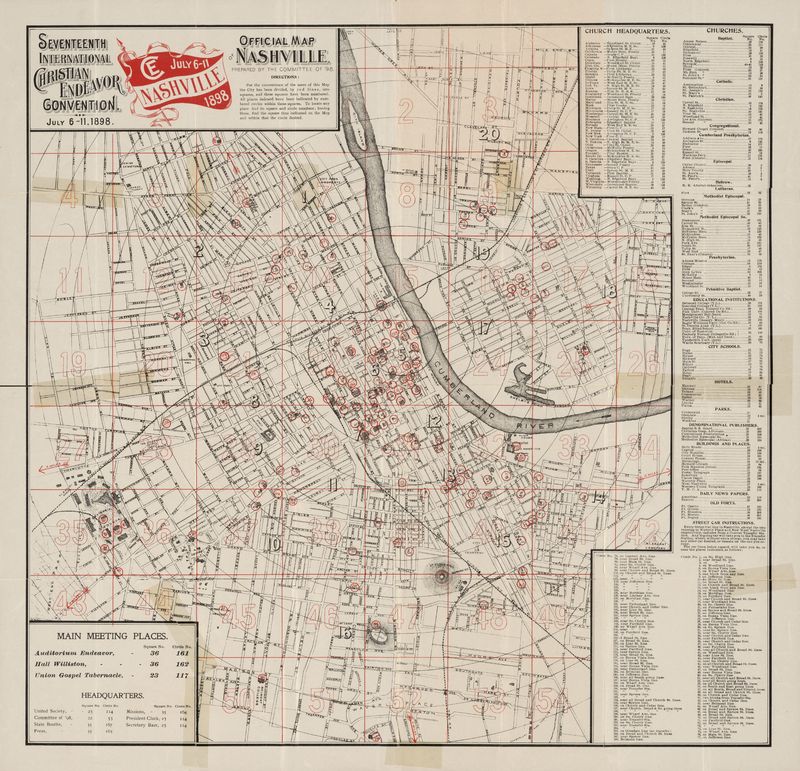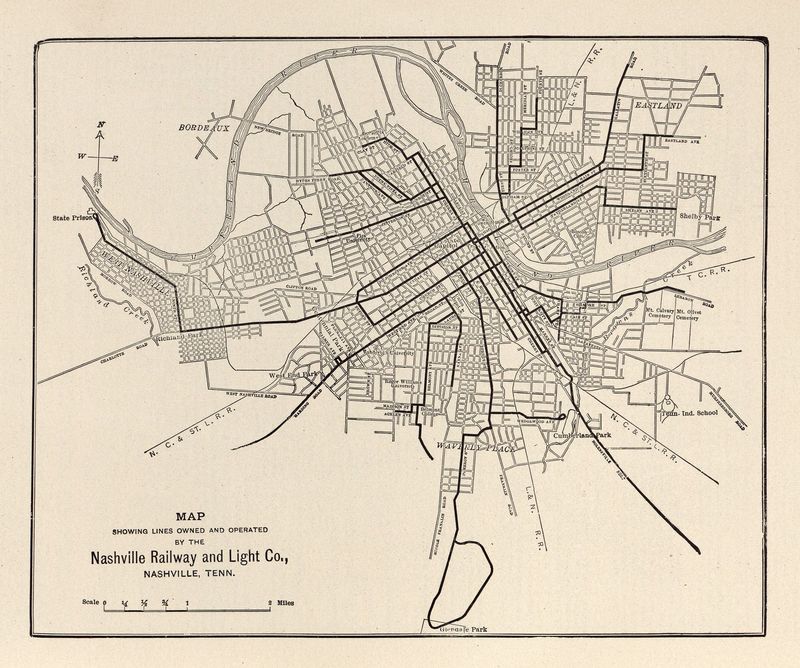Early Maps and Geography
Nashville, 1875. Image courtesy of Ridley Wills II.

Nashville, 1898. Image courtesy of Ridley Wills II.

Nashville, 1913. Image courtesy of Metropolitan Archives.
According to the Tennessee Encyclopedia of History and Culture:
"In 1778 James Robertson of the Watauga settlement in what was then North Carolina scouted the Nashville area with eight men. The following year he returned with a group of close to 250, mostly men and boys, to establish a permanent settlement. They arrived on Christmas Day 1779. Robertson's partner, Colonel John Donelson, brought the families and provisions over one thousand miles by boat down the Holston and Tennessee Rivers and up the Ohio and Cumberland Rivers to the Cumberland Bluffs, arriving April 24, 1780. Within a week, the Cumberland Compact, the first civil government in Middle Tennessee, was signed by 256 men. They named the settlement Nashborough for General Francis Nash of North Carolina. In 1784 Nashborough was changed to Nashville."
"By the early 1800s Nashville was growing rapidly. In 1796 Tennessee had become the sixteenth state. Andrew Jackson's resounding defeat of the British at the battle of New Orleans in 1815 brought new prominence to Tennessee and Nashville, his home. In 1828 Jackson was elected seventh president of the United States, the first "western" president. In 1843 Nashville became the permanent capital of Tennessee. Philadelphia architect William Strickland was hired to design the Greek Revival capitol, completed in 1859 and now a National Historic Landmark."
"Its location on the Cumberland River was critical to the growth of Nashville during the first half of the nineteenth century. The arrival of the first steamboat in 1819 opened the way for trade with cities like New Orleans and Pittsburgh, and Nashville became the main distribution point for goods throughout the Mid-South. Steamboats brought rice, sugar, coffee, and household goods to Nashville and returned with cotton, tobacco, corn, and lumber. In addition to prosperous merchant enterprises, banking, printing, and publishing industries began to grow."
"With the advent of streetcars--first mule-drawn, then electric--Nashville began to grow beyond the downtown area by the mid-nineteenth century. Germantown, Edgefield in East Nashville, and the Cameron-Trimble community were established at this time. In 1897 the Tennessee Centennial Exposition was held where Centennial Park stands today. A wood and stucco replica of the Parthenon was such a popular building that the city, already called the Athens of the South because of its educational institutions, built a permanent reconstruction in concrete in the 1920s, now the only full-scale facsimile of the Parthenon in existence."
"As population increased, Nashvillians continued to move west and southwest to streetcar suburbs now known as Woodland-in-Waverly, Waverly-Belmont, Belmont-Hillsboro, and Richland-West End. The Great Depression and suburban expansion led to the decline of former residential areas downtown. In 1949 Nashville launched the first postwar urban renewal program in the country, the Capitol Hill Redevelopment Project. . . Nashville became the first major Southern city to experience widespread desegregation of public facilities. In 1963 Nashville and Davidson County merged, becoming the first consolidated city/county government in the United States."
The census of 1890 reported Nashville to be the third largest city in the South, with a population of 76,168 behind New Orleans (242,039) and Richmond (81,388) and ahead of Atlanta (65,533). However, the city’s rate of growth did not match that of Memphis, Birmingham, or Atlanta (which passed Nashville’s population in 1900). In 2017, the population of Nashville topped 700,000, and metropolitan Nashville (which includes six-neighboring counties) is over 1.8 million.
Citation:
Opehlia Paine and John Lawrence Connelly, “Nashville,” Tennessee Encyclopedia of History and Culture, online edition, http://tennesseeencyclopedia.net/entry.php?rec=964.
